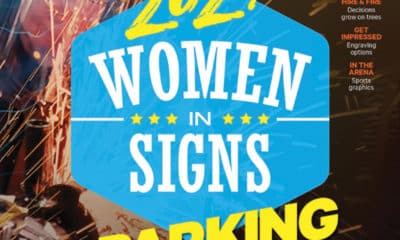Many people have relaxed attitudes about sign surveys. Our shop, for example, has employed salespeople who simply couldn’t understand a site survey’s importance — how their poorly done photos and insufficient data could directly affect their sales and commission, plus the shop’s profits. I often wonder if such salespeople think our shop designers are psychic. They don’t realize that scarce or inaccurate information wastes a sign designer’s time, not to mention the shop crew might fabri¬cate a sign that doesn’t fit or requires unexpected dollars to install.
Well-done surveys can save your shop money, help you sell signs and help you obtain installation contracts from other sign companies. Our shop receives many such survey requests from distant signshops. Generally, these entail a site survey and local permit requirements. We strive to promptly return accurate information and are often asked to install the signs. We’ve also been asked to fabricate and install such signs.
Because surveys can both cost and make money, let’s review a “best-practices” survey format — the photos, site plans, scaled drawings and the permit information.
Photographs
A straight-on photo of the proposed installation site is mandatory. It gives clear information and, within reason, can become a measurement reference by scaling it in Photoshop, Corel or your sign-design software. If you’re using photo prints, you can scan and import them into your software or simply resize the print, to scale, on your office copier.
Typically a salesperson does not have ladders or other equipment needed to measure an elevated sign. He or she can, however, measure a given length on the sign pole (or other vertical objects) and mark it with an easily identified tape. A competent designer can resize the image later, to fit the measured distance to a particular scale.
Advertisement
A straight-on photo will show the tape mark, thus allowing your designer to create an estimated scale by referencing the space between the tape and ground. This measurement will help you scale a reasonably close dimension of the topside sign. Use blue masking tape, orange surveyor’s tape or brightly colored, adhesive-back vinyl tags for the mark. To avoid misunderstandings, pick one color and stay with it.
Also, a 4-ft. measurement works best, because, in software, it’s easily matched to 1 in., thereby sizing the entire image at ¼ in. = 1 ft. (Editors note: In Photoshop, your designer can apply the perspective-control tool to correct lens parallax [the fall-away effect] by pulling the sign image vertical. This will provide an even more accurate sizing reference.)
I recommend four views, one from each side, where possible, and two at 30° to 45° angles, which shows the entire site.
Site plan
Your site plan must show the sign’s relation to streets and buildings. It should also identify the photogra¬pher’s position on the site plan. Again, consistent positioning prevents misunderstandings. Clearly identify each photo as it’s referenced on the site plan (”A,” “B”, “C,” and so on) and include these references in any notes or comments.
Service vehicle
Advertisement
Have your service crew perform surveys where exact measurements and construction details are needed — a face change for a contracted, pole sign, for example. To avoid installation-day surprises, your sign designer must know the face and retainer sizes, plus any hanging rail details.
Data Packet
Include this information in your survey data packet:
• Sign buyer’s name, address, telephone and email;
• Name of business;
• Brief description of sign;
Advertisement
• Site address;
• Property owner’s name, address, telephone and email;
• Nearby cross streets and their approximate distance from sign;
• Site oddities (overhead wires, large trees, sloping grade at install site…);
• Linear footage or square of building front (if required for permit);
• Setback footage of proposed sign from street-front property line (if required for permit);
• Underground utilities location papers, if needed; and
• Permit information as provided by the governing office.
You may also want to identify local contractors: excavators, concrete suppliers and crane-rental companies, for example.
Because surveys are seldom included in the subsequent estimate, try to complete them while the truck is enroute to other calls, so the travel cost can be absorbed. Our work orders list a distinct survey-identification number, so the service manager can quickly see that it’s a no-profit task.
Also, while up high, have your surveyor (usually a sign service man) inspect the sign for maintenance needs that could be corrected during the face change.
Customer-requested surveys
Sometimes our regular customers request surveys of new or existing sign sites, so they can plan future face trades or other work. These requests may spawn from corporate buyouts or re-imaging plans. The survey may include several sites, requiring size and price details for each.
Keep in mind, the customer is asking for a no-cost, survey/bid package. You may provide the surveys and not sell anything. In such cases, we offer them artwork reflecting the survey, but don’t draft to scale or list exact dimensions. Further, we write “Property of [your company name]” on the drawing, to advise our customer that the infor¬mation is for his eyes only.
And, although we provide a fair and accurate price, we typically round off our drawing’s measurements, knowing that our customer may contact other signshops with these surveys in hand. We don’t mind offering surveys and pricing, but prefer our competition not compete with us at our expense. Rounding off measurements makes any competitor not very competitive.

 News4 days ago
News4 days ago
 Projects2 weeks ago
Projects2 weeks ago
 News2 weeks ago
News2 weeks ago
 How To1 week ago
How To1 week ago
 Real Deal5 days ago
Real Deal5 days ago
 Editor's Note6 days ago
Editor's Note6 days ago
 Photo Gallery3 days ago
Photo Gallery3 days ago
 Product Buying + Technology7 days ago
Product Buying + Technology7 days ago
















